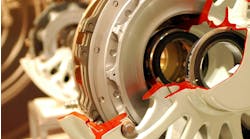A commercial fisherman did some major maintenance and repair on his 42-ft shrimp trawler. Some of the new equipment included a hydraulically powered refrigeration unit to keep the catch cold for up to a week and the pinch puller that hauls in the net full. He chose hydraulics over electrically-powered alternatives based on their simplicity and reliability. With electric motors and refrigeration, the owner would have to add an ac panel, exhaust, and lots of wiring. This would increase the chances of failure and force him to add an engineer to his two-man crew. With hydraulics, the refrigeration unit and puller could be in in a flooded engines room and they would still work.
When the boat was finished and taken out for test runs, the owner/operator couldn’t help but notice the hydraulics created lots of noise, with the refrigeration unit also adding a high-pitched squeal. Ear plugs and sound-deadening headphones helped, but they also made it impossible for the operator to hear or communicate with his crew, which was unacceptable. And the whine from the refrigeration unit , which had to run 24/7, prevented anyone on the boat from getting a decent night’s sleep.
To quiet the boat, the owner looked into adding pads and insulation. But the boat is relatively small and there was little space between the bulkheads and the equipment for sound-deadening material. So, he replaced as many 90-deg. turns in the hydraulic lines as he could and added rubber grommets in the lines, hoping to lower the noise level. He also considered encasing the hydraulics in a plywood and foam cover. But the owner likes to have access to the equipment: He feels the hydraulic lines and checks their temperature by hand. If they are hot, he knows the fluid level is low.
None of this worked very well.
Eventually, the owner found a hydraulic noise and shock suppressor available from Wilkes & McLean. It reduces the amount of pulsations in a hydraulic system and thereby reduces the noise the system generates while extending the life of the hydraulic pump and components.
The suppressor consists of a diffuser tube encased in a sleeve-type bladder. The diffuser tube acts as a baffle, forcing the hydraulic fluid to travel through 0.50-in. holes in the spool and then through a metal case perforated with hundreds of 0.03125-in. holes. The baffles and sleeve take out most of the pulsations without restricting fluid flow.
The suppressor is simply connected into the hydraulic line just downstream of the hydraulic pump. There are no electronics, but the sleeve bladder must be charged with nitrogen. The suppressors come in a range of sizes, with the largest unit capable of handling 5,000 psi and 200 gallons per minute, and they can be installed vertically or horizontally with no effect of operation.
At first the boat crew pre-charged the suppressor with nitrogen at 50% of the hydraulic system’s operating pressure as the manufacturer suggested. However, after further studies the crew has experienced better results charging it to about 75% of operating pressure.



